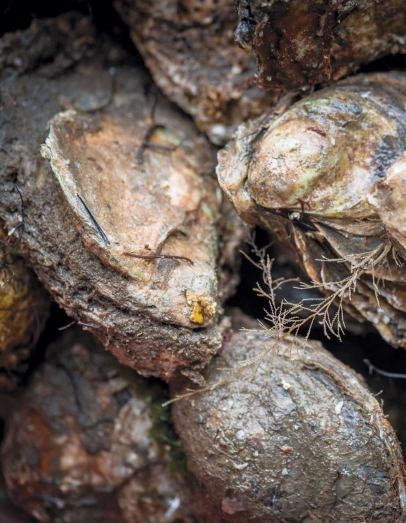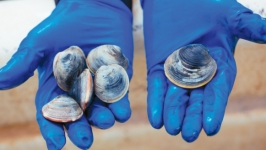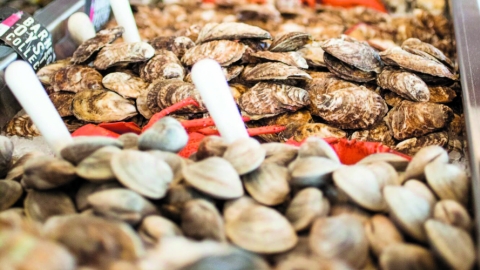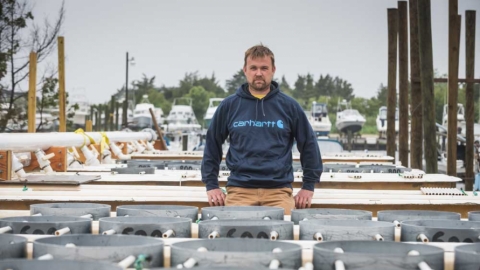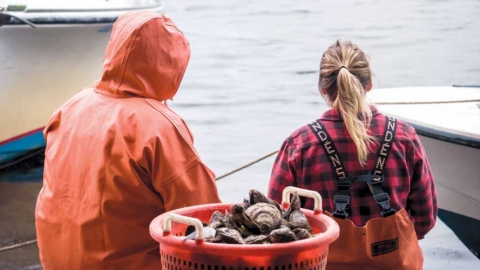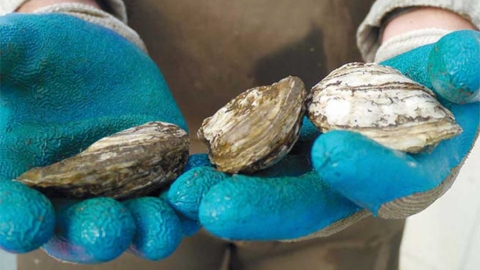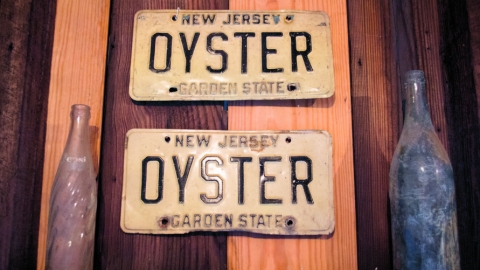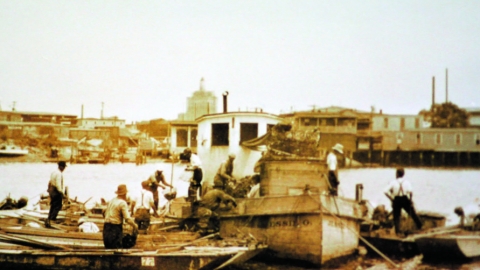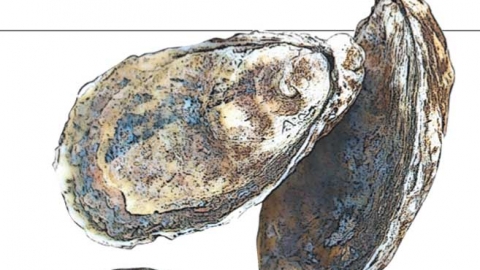SPECIAL REPORT: Oysters
Perhaps no food conveys a sense of place like the oyster. To tip back a Cape May Salt or Forty North Rose Cove and sip its brine is to kiss its native waterway on the lips, in a paraphrase of French poet Léon-Paul Fargue. It is to commune with season and location, a humble creature transformed by salt and time into something far more grand. It is to taste the point where river gives way to sea, the best of two ecosystems colliding.
Corinne Ruff, director of the documentary The Oyster Farmers, says nothing better represents New Jersey. Indeed, were we to choose a mascot for environmental advocacy, the oyster may be the ideal candidate. Low-impact by nature, oyster farming offers great potential as human populations surge. “It’s a green production system at a time when our fishery production is going flat,” says Lisa Calvo, oyster farmer and Rutgers aquacultural extension program coordinator. “We don’t tend to think about that here in the US, but globally it is going to provide an important food source.”
Moreover, the oyster is a barometer for estuarine health. Farming is permitted only in quality waterways, and no nutrients (read: pollutants) need to be added to feed them. The shellfish even acts as a filter, leaving the water better than before.
In fact, the oyster is a powerful environmental steward. Each bivalve filters up to 50 gallons of water a day, feeding on phytoplankton (a form of free-swimming algae) and serving as a living purifier in the process. Multiply that by the millions, and you have a mighty clean-up crew on the job 24/7. In turn, the estuary realizes multiple benefits. For one, clearer waters make room for sunshine, supporting aquatic vegetation like the eel grass that used to offer prime habitat and foraging grounds to young fin fish and crustaceans. “I like to think of the oyster reef as the lungs of the bay,” Ruff says. “Add in more nutrients from fertilizer run-off and over-development and you stress an already stressed system. Building the reef is one step toward giving the bay the chance to catch its breath and in the long term, breathe again.”
The oyster’s chosen home base also has amazing benefits. As bivalves build up on the bottom, other species view the resulting reefs as a kind of aquatic condo complex—or as Ruff says, a hotel. As everything from barnacles to mud crabs move in, species up the food chain take notice and join them, whether as neighbors or predators (or both). The reef also shores up the bottom of the bay, helping to protect against erosion and tidal surges. As sea levels rise and storm events gain strength, the oyster, a potent buffer, offers below-the-surface protection.
In Edible Jersey’s first issue (Summer 2007), publisher Nancy Brannigan Painter tracked the restoration of the oyster in the Delaware Bay. Seeing the oysters as the scaffolding for both an ecosystem and an economy, she uncovered ample reasons for optimism. A decade later, that market has matured, and a new round of innovation is happening along the Atlantic Coast.
Rise and Fall (and Rise) of the Delaware Bay Oyster
As the sun comes up at Money Island Marina, where the Nantuxent Creek and Delaware Bay come together, ship captains and their crews head out onto the water. Aptly named, Money Island is the epicenter for oystering on Jersey’s west coast, where most of its open-harvest catch is landed. By all accounts, that trade is brisk. Peering over the dock from his rustic baymen’s shop, Marina manager Bruce Muenker will tell you that a lot of profit is generated at this onetime salt-hay farm. Tony Novak, president of Baysave, estimates $26 million in annual landings here of shellfish and other catch. That makes it a popular haunt for researchers (not to mention state representatives who track quotas)—which is a good thing. Without the scientists, there’s a good chance the Delaware oyster might be all but extinct, and certainly not prevalent enough to harvest.
When Painter explored the Delaware Bay’s bivalve revival in 2007, it was in the wake of Dermo, a devastating oyster disease. Partnership among stakeholders—the state, scientists, oyster farmers—was bringing the bivalve back from the brink. As then director Eric Powell of the Haskin Shellfish Research Laboratory put it, recovery “required the development of an infrastructure that didn’t exist before.” In part, that involved consumer education and a revamped regional marketing strategy. It also hinged on expanded shell planting along the Cape May Peninsula. By placing large amounts of clean shells on the bottom, more potential was created for larval oysters to attach and continue growing—a process known as recruitment. The more recruitment you have, the healthier the oyster population. “The state, the industry and Rutgers were all in,” says Russ Babb, director of the state Department of Environmental Protection’s Bureau of Shellfisheries. “We planted over 2 million bushels of shell on the bay’s reefs over a period of about five years.”
NJ Now Boasts 28 Oyster Farms
That program’s prescience can be seen in rising quotas today. “Our total allowable harvest this year is going to be north of 124,000 bushels, which is by far the highest since the late ’90s,” Babb says. “In a lot of our direct-market years since 1996, we’ve hovered closer to about 75,000 bushels.” This may not compare to an industry that employed up to 60,000 baymen in the late 1800s. Still, it’s healthy business.
“If you look just at the wild harvest, we’re up 60% compared to 10 years ago,” Babb says, noting that much of it now goes to raw bars. “If you’re eating a half dozen at a time, that’s 5 million plates.” A small-but-mighty aquaculture contingent has also gained steam, crafting a boutique product.
According to Amanda Wenczel, aquacultural development specialist for the New Jersey Department of Agriculture, 16 oyster farms are now operating along the Delaware Bay, and another 12 are operating on the Atlantic. “People who are innovators go to this industry,” Wenczel says. “It’s really in motion.”
Her predecessor, Joe Myers, predicted the rise. “Rack-and-bag (a farming method) could be a very large boom to our seafood production in the state,” he told Painter.
The disease devastated more than the oyster population. It halted the century-long economic prosperity of the small towns lining the Jersey side of the bay, communities that revolved around the oyster industry. . . it was clear that aggressive action was needed to avoid the extinction of the Delaware Bay oyster—and, perhaps, to save the Bay itself. —Nancy Painter, 2007
Myers was correct. Established as the state’s first aquaculture-based oyster farm in 1997 by Atlantic Cape Fisheries, the Cape May Salts brand has leveraged the method to become a powerhouse. Unlike in traditional operations where oysters mature on the bay’s bottom, theirs are placed in growing bags attached to steel racks, which are set in the intertidal zone. The result is a cleaner oyster with a smoother shell that is less likely to become lunch for a predator.
Today, upwards of 2 million Cape May Salts make their way to market annually, and 2017 is a big year for the company, with two brand-new varieties on deck. This summer, diners will be introduced to Elder Point Oysters, which are grown via a deep-water operation that may just usher in the next era of shellfish aquaculture in the state. Grown fully beneath the surface, the oysters have honey-colored shells and a deep cup that holds plenty of liquor and delicate, briny meat. (See page 52, “How Rutgers Revitalized an Industry”) In the fall, watch for an as-yet unnamed oyster that is being grown through a flip-bag method. “They’re tide-tumbled, meaning the bag floats up and down with the tide, so the oyster is constantly shaken around and manicured,” says Brian Harman, farm manager. The resulting bivalve has a round, deep cup, plump meat and a high meat-to-shell ratio.
It’s a perfect example of the innovative spirit Wenczel noted. Oyster farmers continually tease out new flavors and shell shapes through emerging methods.
Oysters being oysters, of course, threats continue to emerge.
An Endangered Species and Rising Seas
Not sure you believe in climate change? Talk to someone in shellfish. At least monthly, muddy waters creep over the docks of the Bayshore Center at Bivalve and into the boat shed at nearby Rutgers Haskin Shellfish Research Laboratory. Accelerated by eroded beaches, the surge pays no heed to property lines, leaving slippery muck in its wake. Tip-toe past the yellow-rope barriers at the Bayshore Center, and you may just fall in.
“We have volunteers who have seen changes to the environment within their lifetimes, and they’re only 70,” says Rachel Dolhanczyk, curator for the Delaware Bay Museum at the Bayshore Center and head of its oral-history program. “They can see where erosion has happened or how the shorelines changed.”
Kathryn Ashton-Alcox, a Haskin-based field researcher, says the erosion is definitely connected to climate change and rising seas. This leaves her worried for places like Money Island, accessible only by long roads through the marsh. “What if the state decides not to maintain that road?” she says. No road means no access to the point where the vast majority of the Delaware Bay’s oysters are landed.
In tandem with flooding, disease remains a threat on both coasts. “As the sea level rises, ocean water moves farther into the bays, and higher salinity is more favorable to the predators and the parasites that cause disease to oyster populations,” explains Dr. David Bushek, Haskin’s director and an expert in disease ecology. “The zone of optimal salinity, how much salt content is in there, also gets compressed.” On the flip side, flash flooding can leave waters too fresh, which can kill oysters over time.
Then there’s the red knot, a migratory shorebird. It was declared endangered in 2014, a declaration that sent Delaware Bay aquaculturists into a tailspin. The reason: The red knot fattens up by feeding on the eggs of horseshoe crabs—and the Delaware Bayshore just so happens to be the largest horseshoe crab spawning ground in the world. Unfortunately, many rack-and-bag oyster operations reside right on the tidal flats where the crabs spawn. Conservationists worry that the farm gear keeps the crabs from making it to shore, and that the humans scare the birds away. (See: “Oysters & Knots,” Edible Jersey Spring 2016) “A lot of recent research interest has gone into interactions, and how we can have a viable habitat for horseshoe crabs and red knots, but also have opportunities to grow this industry,” Babb says. Currently, he says, hard data is limited.
While more is collected, a biological opinion by the US Fish and Wildlife Service New Jersey Field Office was adopted in April 2016. It established two discrete areas of focus, or action zones, in which a balance between support for aquaculture and protection of the red knot is set. Importantly, the opinion also keeps farmers in compliance with the Endangered Species Act. The southern zone, where tidal flats are wider, offers flexibility. “There’s a lot more room for red knot use as well as horseshoe crab spawning as well as aquaculture,” Babb says.
Conservation takes precedence in the northern zone, affecting farmers such as Calvo, who can only access her Sweet Amalia oyster farm twice weekly from May 1 through June 7 due to environmental agency regulations. Given her other role as a Rutgers aquaculture extension program coordinator, she’s both frustrated and sympathetic. “Demand is strong, and I’m at the point where it would be smart to grow,” Calvo says. “Yet it’s a challenge. Who knew that this less than 10-acre footprint of habitat used by Delaware Bay oyster farmers was going to impact this species that’s migrating globally?”
Calvo remains hopeful for eventual coexistence. To guide things in the interim, the DEP created a stakeholder committee comprised of conservation groups, aquaculturists, academics and others with an interest in finding a more permanent solution.
Despite all of this, Dolhanczyk thinks the future of the shellfish industry in New Jersey is worth the fight. “I would love to see more of an awareness and appreciation of the Delaware Bay,” she says. “It’s not going to be like it was in the ’20s, with guys lighting their cigars with $100 bills. But I would like to see the people who choose to work the water, whether wild-caught or in aquaculture, able to make a living.”


